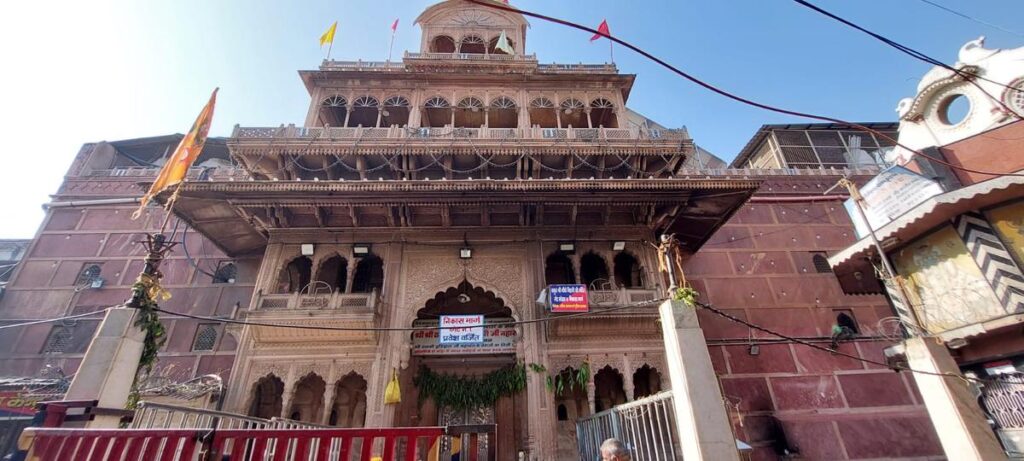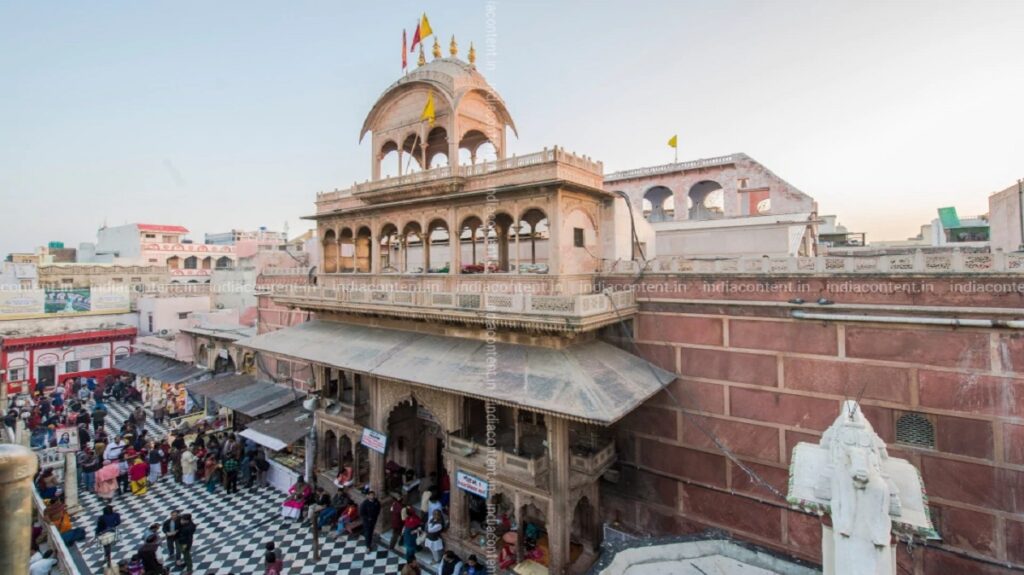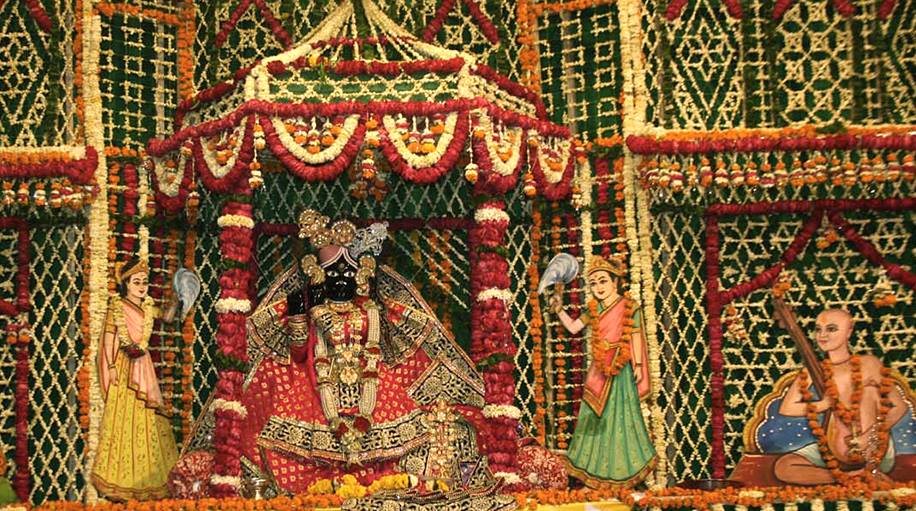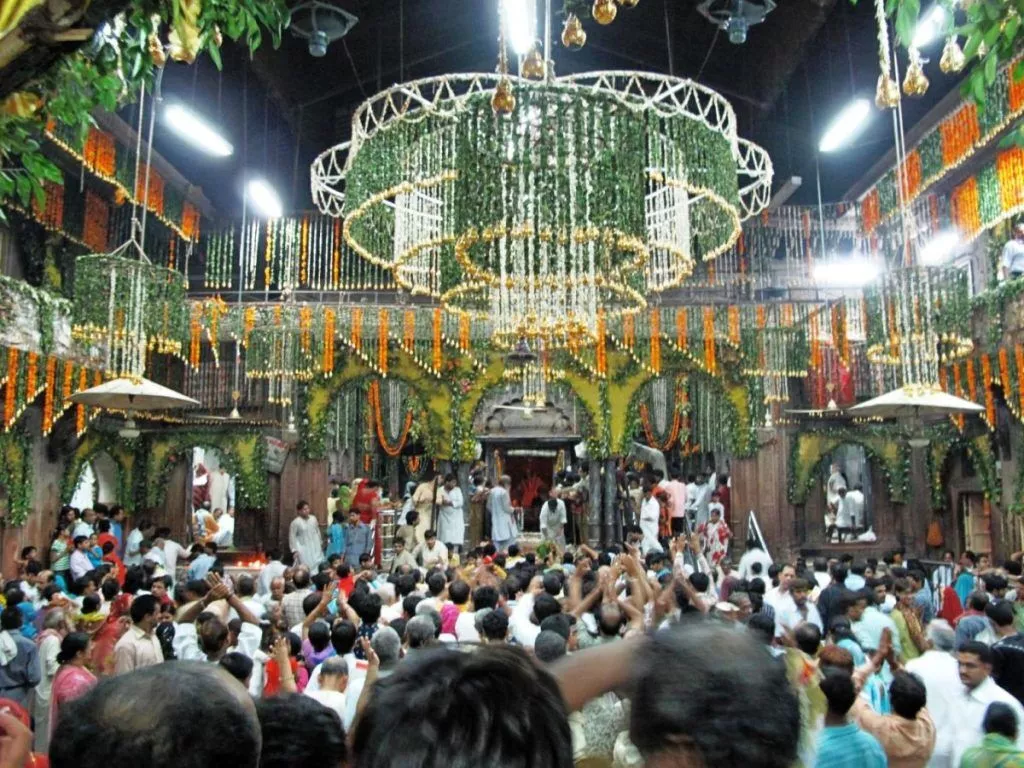
Banke Bihari Temple
Nestled in the sacred town of Vrindavan in the state of Uttar Pradesh, the Banke Bihari Temple is a revered Hindu shrine dedicated to Lord Krishna. The temple is a significant pilgrimage destination and holds a special place in the hearts of devotees. Its name, “Banke Bihari,” translates to “Bent at the waist,” depicting the playful and endearing posture of Lord Krishna. The temple is known for its vibrant devotional atmosphere, intricate architecture, and the divine idol of Lord Krishna, which attracts a multitude of pilgrims and visitors seeking spiritual solace. The Banke Bihari Temple stands as a testament to the rich cultural and religious heritage associated with the life of Lord Krishna in Vrindavan.
Namaste 🙏 नमस्ते
Secure your visit • अपनी यात्रा सुरक्षित करें
Historical background and Architectural splendor
This Temple has a history deeply entwined with the cultural and spiritual legacy of Vrindavan. It is believed that the original idol of Lord Krishna installed in the temple was discovered in the Nidhi Vana by the great saint Swami Haridas. The temple was later established to enshrine this divine manifestation of Lord Krishna. Over the years, the temple has witnessed renovations and enhancements, evolving into a revered pilgrimage site that attracts devotees from far and wide. The devotional ambiance and the profound connection to the life and teachings of Lord Krishna contribute to the historical significance of the Banke Bihari Temple.
Architectural Splendor:
The architecture of the Banke Bihari Temple showcases a blend of traditional and Rajasthani architectural styles. The temple’s exterior is adorned with intricate carvings and detailed craftsmanship, reflecting the devotion and artistic brilliance of its builders. The sanctum sanctorum houses the mesmerizing idol of Lord Krishna in his renowned “Tribhanga” pose, depicting a three-fold bending form. The inner sanctum is a sanctified space resonating with the divine energy, creating a spiritually uplifting atmosphere for devotees. The temple’s architectural grandeur and the divine aura surrounding the idol make the Banke Bihari Temple a captivating destination for those seeking both visual and spiritual enrichment.

Religious Significance
The religious significance of this temple lies in its association with the devotional Bhakti movement. The deity, Banke Bihari, is considered to be a playful and mischievous form of Lord Krishna, and the temple is a sacred space for devotees seeking a deep, personal connection with the divine. Devotees believe that the Banke Bihari Temple embodies the essence of pure devotion and love for God. The temple is known for its unique and intimate style of worship, characterized by the swinging of the deity during the darshan (viewing) by the devotees. The image of Banke Bihari is adorned with various ornaments, and the temple's atmosphere is charged with the enchanting tunes of devotional songs and hymns. Pilgrims visit the temple to experience a profound spiritual connection with Lord Krishna, seeking solace, guidance, and divine blessings. The Banke Bihari Temple is not just a physical structure but a spiritual haven that fosters devotion and a sense of transcendence for the countless worshippers who come to partake in the divine presence of Banke Bihari.


Festival and Celebrations
Here the festivals celebrated are Janmashtami, Swing Festival (Jhulan Yatra), Radha Ashtami, Sharad Purnima, Govardhan Puja and Nandotsav.
Surroundings area & attractions
- Radha Raman Temple: Dedicated to Lord Krishna, it houses a unique and ancient deity of Radha Raman.
- Prem Mandir:A beautifully constructed temple depicting the divine love of Radha and Krishna, adorned with vibrant illuminations.
- ISKCON Vrindavan:The ISKCON temple offers spiritual teachings and vibrant kirtans, enriching the devotees' spiritual experience.
- Seva Kunj and Nidhuban: Serene gardens believed to be the sites of divine pastimes of Radha and Krishna.
- Kesi Ghat: A sacred bathing spot on the Yamuna River, believed to purify the soul.
- Vrindavan Chandrodaya Mandir: An upcoming tall religious structure with a museum, helipad, and facilities for spiritual and cultural activities.
FAQ
The Banke Bihari Temple is a Hindu temple dedicated to Lord Krishna, specifically in his childhood form as Banke Bihari. It is located in Vrindavan, Uttar Pradesh, India, a town renowned for its association with the life and teachings of Lord Krishna.
Banke Bihari is a beloved form of Lord Krishna, depicting him in his playful and charming childhood years. The name “Banke Bihari” translates to “bent at the waist,” symbolizing the charming posture of Lord Krishna.
The Banke Bihari Temple was established in the 19th century. The exact date of its construction is not precisely known, but it has been a prominent place of worship for devotees of Lord Krishna for many years.
The temple holds immense significance for devotees of Lord Krishna, who flock to the temple to seek his blessings and grace. It is believed that worshiping Banke Bihari brings joy, fulfillment, and spiritual upliftment.
The Banke Bihari Temple celebrates various rituals and festivals throughout the year, including Janmashtami (the birth anniversary of Lord Krishna), Holi (the festival of colors), Radhashtami (the appearance day of Radha, Krishna’s consort), and others. Daily rituals such as aarti and bhajans (devotional songs) are also performed.
While there may not be a strict dress code, visitors are encouraged to dress modestly and respectfully when visiting the temple. Avoiding revealing or inappropriate attire is appreciated out of reverence for the sacredness of the place.
Yes, devotees are welcome to offer prayers, perform rituals, and participate in the daily aarti and bhajan sessions at the Banke Bihari Temple. The temple provides opportunities for devotees to engage in devotional activities and seek the blessings of Lord Krishna.
Photography rules may vary, but generally, photography inside the temple may be restricted, especially in the inner sanctum where the deity is worshiped. It’s advisable to inquire with the temple authorities or priests regarding photography guidelines.
Yes, the Banke Bihari Temple complex provides various facilities for pilgrims and visitors, including rest areas, drinking water facilities, and shops selling religious items and souvenirs. Additionally, nearby eateries and accommodation options cater to the needs of visitors.
Yes, non-Hindus are welcome to visit the Banke Bihari Temple and experience its spiritual ambiance. However, visitors are expected to respect the religious sentiments of devotees and observe the rules and customs followed at the temple.
According to legend, the idol of Banke Bihari in the temple appeared on its own. It is said that the great saint Swami Haridasji, who was a devotee of Lord Krishna, once saw the divine form of Banke Bihari during his meditation. He requested the deity to appear in a physical form so that he could worship him. The deity obliged, and the idol of Banke Bihari manifested itself in the temple.
The temple follows specific darshan timings for devotees to have a glimpse of the deity. These timings may vary on different days and during special occasions. Devotees often line up early in the morning and in the evening to attend the darshan.
The Banke Bihari Temple is famous for its unique celebration of Holi, known as ‘Thakur Ji ki Holi.’ During this celebration, the temple priests throw colors on the deity of Banke Bihari and on devotees. It is a vibrant and joyous occasion that attracts thousands of devotees from all over the world.
Yes, during the ‘Thakur Ji ki Holi’ celebration, special rituals and ceremonies are performed. Devotees sing and dance to devotional songs (bhajans) in praise of Lord Krishna. The priests offer abhishekam (ritual bathing) to the deity with colored water, and devotees join in the festivities by applying colors to each other.
Yes, the primary deity worshipped at the Banke Bihari Temple is Lord Krishna in his childhood form as Banke Bihari. The deity is depicted with a charming and playful demeanor, often portrayed in a standing posture with bent knees (tribhangi).
Devotees can offer various forms of seva at the Banke Bihari Temple, including flower offerings, lamp lighting, and donation of food or money for temple maintenance. Some devotees also volunteer their time to assist in temple activities or services.
The Banke Bihari Temple features traditional North Indian temple architecture with intricate carvings and designs. The main shrine where the deity is housed is typically adorned with ornate decorations and colorful paintings depicting scenes from Hindu mythology.
Yes, there are numerous legends and stories of miracles associated with Banke Bihari, where devotees believe that the deity grants their wishes and fulfills their prayers. These stories often highlight the divine grace and compassion of Lord Krishna towards his devotees.
Yes, devotees often offer prasad such as sweets, fruits, and other vegetarian items to the deity at the Banke Bihari Temple. The prasad is considered blessed and is distributed among devotees after being offered to the deity.
Yes, visiting the Banke Bihari Temple during festivals like Janmashtami (the birth anniversary of Lord Krishna) or Radhashtami (the appearance day of Radha, Krishna’s consort) is considered highly auspicious.
Visitor information
Entry Fee: No fee
Darshan Timing:
-
7:45 am – 12:00 pm
5:30 pm – 9:30 pm (Summer) -
8:45 am – 1:00 pm
4:30 pm – 8:30 pm (Winter)
Darshan Days- All days
Address:
Madan Mohan Bankey Bihari Road, Vrindavan, Uttar Pradesh, 281121, India
Notable Events and Incidents
- Phool Bangla Festival: Annual event when the temple is decorated with flowers, and the idol of Banke Bihari is adorned with floral arrangements.
- Swinging Ceremony (Jhulan Yatra) Devotees celebrate the divine love of Radha and Krishna by placing the deities on a swing.
- Janmashtami Celebrations: Janmashtami, the birth anniversary of Lord Krishna, is celebrated with great fervor at the Banke Bihari Temple.
Connectivity :
- By Air: The nearest airport to Vrindavan is the Indira Gandhi International Airport in New Delhi, approximately 150 kilometers away.
- By Rail: Mathura Junction is the closest railway station to Vrindavan, located around 14 kilometers away. Mathura is well-connected to major cities in India.
- By Road: Vrindavan is well-connected by road to cities like Delhi and Agra. Visitors can use buses, taxis, or private vehicles to reach Vrindavan. The town is easily accessible from major highways.
